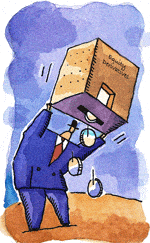Corporations might be wary of employing complex financial instruments in the wake of the credit crunch, but a closer look at the anatomy of the meltdown suggests equity derivatives still present some interesting opportunities.
 |
This helped fuel a global boom in equity derivatives trading. The notional value of over-the-counter (OTC) equity derivatives, including options, forwards and swaps, peaked at $9.2 trillion in June 2007, a 36% increase over the $6.8 trillion racked up a year earlier, according to the Bank for International Settlements.
It seemed like the best of all possible worlds for quant funds and their Midas-touch managers—until the subprime meltdown turned their world on its head. “More and more hedge funds doing the same thing created a vicious cycle where volatility was in constant decline,” says Ed Tom, equity derivatives strategist at Credit Suisse in New York.
The first sign that the party for quant funds might soon be over came in March 2007, when subprime mortgages started going bad. Hedge funds survived the first shot of turbulence and came back strong—until August 2007, when the subprime speculative bubble burst, throwing equity markets around the world into turmoil.
Unlike four months earlier, this time markets didn’t settle down, and volatility kept creeping up. “Statistical arbitrage strategies blew up in August,” says Tom, adding that for the first time quant funds found themselves in loss positions. Because quants are highly leveraged, they were suddenly forced to unwind to cover short positions, which had a huge trickle-down effect. New-York based investment bank Goldman Sachs was one of the biggest losers, with its Global Equity Opportunities Fund posting a $1.4 billion decline in assets in the first week of August as its computerized quantitative investment strategies unraveled. “By and large they performed very badly,” says Kevin Woodruff, head of North American equity derivatives at New York’s Morgan Stanley, referring to the performance of quant funds in 2007. “This had a spill-over effect into the larger market and overwhelmed what other investors were doing,” he adds.
Why did things go so terribly wrong? Samuel Rosenberg, head of derivative equity sales for the Americas at Société Générale, says quant funds were assumed to be largely bulletproof in the short to medium term. The problem is that no one realized until it was too late that these sophisticated investment vehicles were virtually all pursuing similar strategies. “When everybody began unwinding at the same time, they were making the same trades,” says Rosenberg. This situation, along with the fact that many hedge funds had significant exposure to CDOs (collateralized debt obligations) derived from subprime mortgages, exacerbated market volatility and deepened the hedge-fund trap.
“Quantitative models work most of the time,” says Yisong Tian, finance specialist at the Schulich School of Business in Toronto, “but when you take it too far … models break down.” In the case of statistical trading, a growing number of copycat funds were chasing the same deals until the subprime debacle and related liquidity crunch.
Many quant-fund managers were relative newcomers to the investment industry, with an average of four years’ experience. “To run these funds you need very high-tech training,” says Tian. “Newly minted PhDs working for a few years have these technical skills, and they’re attracted to this kind of trading.” The attraction is not hard to understand when you consider that quant-fund managers and star traders could easily earn upward of $10 million a year executing their strategies. “Before things blow up, you can become very wealthy, then move on to something else,” says Tian.
Back in the Game
Warren Buffet has described speculative derivatives as “financial weapons of mass destruction.” Looking at the quant-fund crisis of 2007 through a rear-view mirror, it is hard to say if any real lessons have been learned. “There are no obvious answers,” says Rosenberg. Tian adds: “I don’t see how regulations would prevent these types of scenarios. You can’t regulate speculation.”
Ironically, the same investment banks that took significant positions in quant funds and CDOs, including Citi, Merrill Lynch and UBS, have largely been recapitalized with the help of derivates. For example, Citi received a $7.5 billion capital infusion in the form of a convertible preferred stock investment from the Abu Dhabi Investment Authority, a foreign investment fund. Merrill Lynch accepted a $5 billion investment from Temasek Holdings of Singapore.
Through 2008, higher market volatility, continuation of the credit crisis and increased likelihood of recession in the United States will be the dominant themes. But it is not all bad news for equity derivatives, which are expected to have a strong year. “It’s a good time for equity structured products,” says Société Générale’s Rosenberg. “People are looking for places to invest assets. Fixed income is depressed, real estate is down, and that creates great opportunities on the equity side.”
However, long positions on traditional equities are not likely to be the strategy of choice, in part because weaker balance sheets at some of the leading investment banks will probably result in dividend cuts, says Tom with Credit Suisse. “If banks start cutting dividends, value investors will start leaving these stocks,” he says, adding that stagflation is also likely to become a challenge this year.
That means quant and equity-arbitrage funds are expected to come roaring back this year, albeit with less leverage. Other key areas where equity structures are expected to see extensive use is in building and hedging stakes in potential takeover targets, and in helping finance acquisitions through non-recourse margin loans. For example, in the $54 billion takeover battle for Spanish energy utility Endesa in 2007, Enel utilized equity-linked swaps. Although Enel’s bid was in the end unsuccessful, the swaps allowed Italy’s biggest utility to build up its initial stake without the target’s knowledge.
The young guns who ran quant funds from Wall Street to Hong Kong in 2007 are down, but they are not out. How much their trading strategies going forward reflect lessons learned remains to be seen.
Erik Heinrich



